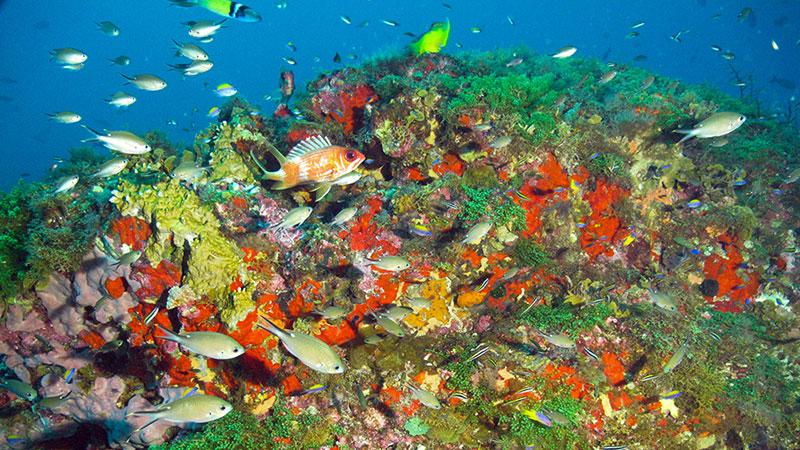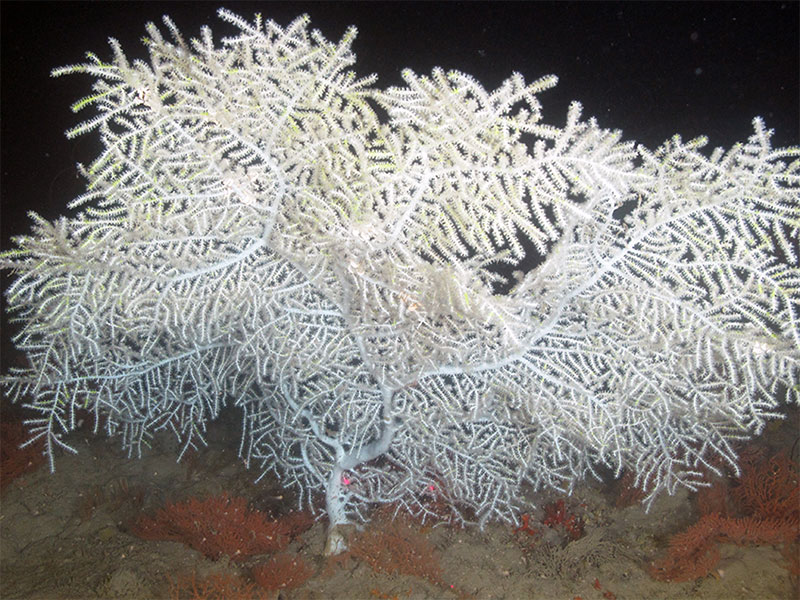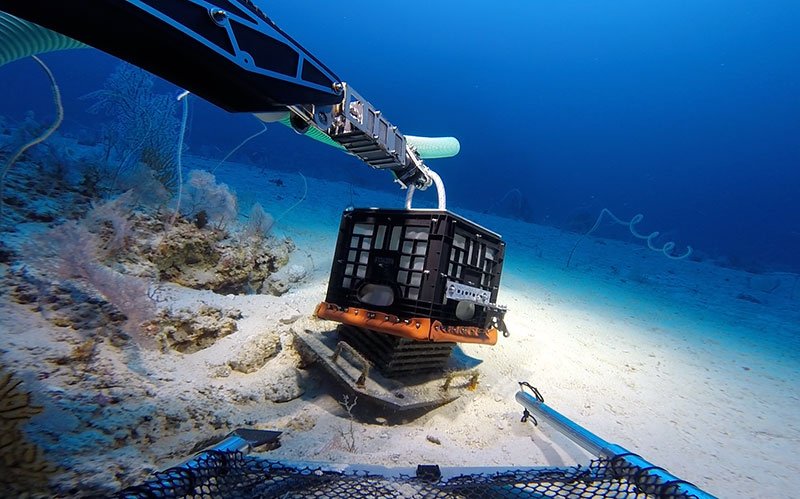
By Santiago Herrera, Ph.D., Assistant Professor and Project Lead, Lehigh University

Figure 1. At a depth of 35 meters (115 feet), Bright Bank features an algal/sponge community typical of many shallower bank areas. Image courtesy of NOAA Flower Garden Banks National Marine Sanctuary/University of North Carolina Wilmington-Undersea Vehicles Program. Download larger version (jpg, 843 KB).
We are studying the coral ecosystems found on the reefs and banks to the east of the Flower Garden Banks National Marine Sanctuary to determine their potential connectivity to the reefs of the sanctuary and other coral ecosystems further afield in the Gulf of Mexico and the Caribbean. These reefs and banks are part of the Flower Garden Banks National Marine Sanctuary’s proposed expansion and understanding how they may or may not be connected to each other and the current sanctuary will help resource managers better protect, restore, and conserve these resources.
The Flower Garden Banks National Marine Sanctuary and the proposed expansion area are home to both shallow and mesophotic coral ecosystems (Figure 1). Mesophotic coral ecosystems in the Gulf of Mexico are typically found at depths from 30–40 meters (98–131 feet) to over 100 meters (328 feet), and are populated with organisms typically associated with shallow coral reefs (such as corals, macroalgae, sponges, and fishes), as well as species unique to mesophotic depths or deeper.
The reefs and banks in the northwestern Gulf of Mexico are spatially separated and each serves as an oasis or biodiversity hotspot by locally enhancing the abundance and diversity of invertebrates and fishes. Knowledge of the factors that promote or impede the connectivity of these ecosystems is essential to ensure the resilience and sustainability of marine ecosystems. Determining the distance, rate, and directionality of larval and adult dispersal for key species is central to understanding how populations are interconnected and the degree of resiliency in the event of a local perturbation, such as an oil spill.
Our goal is to provide information to improve management and protection of shallow and mesophotic coral ecosystems, inform restoration, and help preserve the long-term viability of these ecosystems. To meet this goal, we have assembled a team of 16 scientists at 7 different universities (Lehigh University, Harvey Mudd College, Georgia Institute of Technology, Florida Atlantic University–Harbor Branch Oceanographic Institution, New York City College of Technology, University of New Brunswick, and the Universidad de los Andes in Colombia); three federal laboratories (NOAA’s National Centers for Coastal Ocean Science and Southeast Fisheries Science Center and the U.S. Geological Survey); and the Smithsonian Institution. Our study is funded by NOAA's National Centers for Coastal Ocean Science and Office of Ocean Exploration and Research. Our activities can be categorized under two broad objectives: understanding connectivity and characterizing biodiversity.
We have selected eight species with various life histories to serve as our model species for understanding connectivity: two sea fans (Hypnogorgia pendula and Swiftia exserta), two hard corals (Montastraea cavernosa and Orbicella faveolata), one black coral (Stichopathes lutkeni), one sponge (Xestospongia muta), and two fishes (Red Snapper Lutjanus campechanus and Tomtate Haemulon aurolineatum) (Figure 2).

Figure 2. The sea fan, Hypnogorgia pendula, one of our focal species, is found throughout the northwestern Gulf of Mexico. Pictured at Bouma Bank, 79 meters (259 feet). Image courtesy of NOAA Flower Garden Banks National Marine Sanctuary/University of North Carolina Wilmington-Undersea Vehicles Program. Download larger version (jpg, 6.1 MB).
For each species, we will develop models to predict the potential larval connectivity using information on currents and their biology and reproduction and compare this to genetic samples to understand if the populations on each reef/bank are connected to each other. We will also use predictive modeling to identify areas that are suitable for adults of these species to live. Lastly, we will look at trophic connectivity, i.e., what the organisms eat and how they use the habitat, by measuring an organism’s chemical elements using stable isotopes. By comparing stable isotope values of tissues that have different turnover rates (e.g., muscle = fast and bone = slow), we will get an idea of the organism’s habits. For example, if the short and long turnover tissues have similar isotope values for a fish species, then they likely stay close to their food source over time and don’t move around much. Together, this type of connectivity information is useful to resource managers to understand what habitats are important for different species and helps with their conservation planning.
To better understand what organisms live in mesophotic coral ecosystems in the northwestern Gulf of Mexico, we will be using autonomous reef monitoring structures or ARMS (Figure 3). ARMS provide three-dimensional artificial substrate that mimic the structural complexity of coral reef environments and attract coral species and small reef fishes to colonize or recruit to them. They also document ‘hidden’ biodiversity associated within these ecosystems, organisms that we may not easily collect or see. We will be setting out approximately 50 ARMS so that we can compare the reefs/banks to see if similar organisms inhabit them.

Figure 3. Autonomous reef monitoring structures or ARMS are used by scientists to study biodiversity on coral reefs. These three-dimensional structures are deployed on a reef for two years to allow organisms to colonize them. ARMS being recovered by a submersible at 91 meters (300 feet) depth. Image courtesy of the Smithsonian DROP Program and Substation Curaçao crew. Download larger version (jpg, 979 KB).